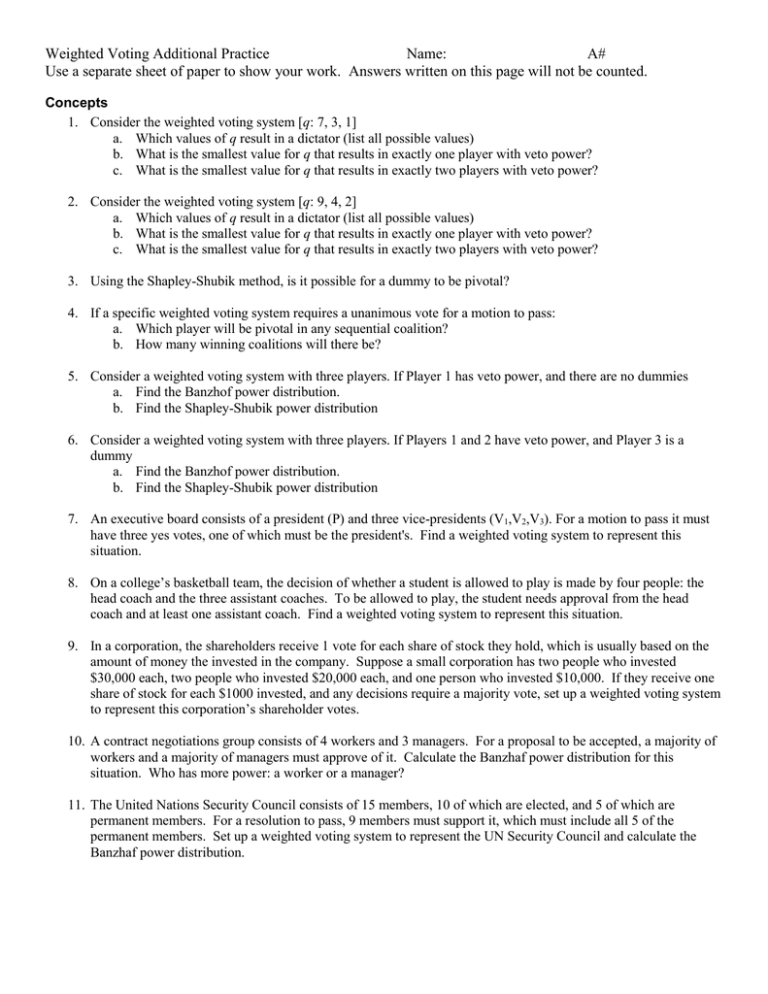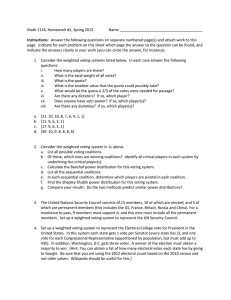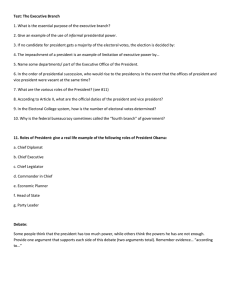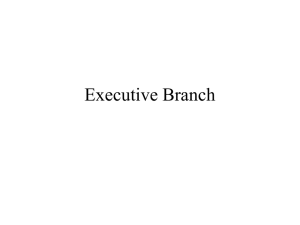Exploration - mathwithkss
advertisement

Weighted Voting Additional Practice Name: A# Use a separate sheet of paper to show your work. Answers written on this page will not be counted. Concepts 1. Consider the weighted voting system [q: 7, 3, 1] a. Which values of q result in a dictator (list all possible values) b. What is the smallest value for q that results in exactly one player with veto power? c. What is the smallest value for q that results in exactly two players with veto power? 2. Consider the weighted voting system [q: 9, 4, 2] a. Which values of q result in a dictator (list all possible values) b. What is the smallest value for q that results in exactly one player with veto power? c. What is the smallest value for q that results in exactly two players with veto power? 3. Using the Shapley-Shubik method, is it possible for a dummy to be pivotal? 4. If a specific weighted voting system requires a unanimous vote for a motion to pass: a. Which player will be pivotal in any sequential coalition? b. How many winning coalitions will there be? 5. Consider a weighted voting system with three players. If Player 1 has veto power, and there are no dummies a. Find the Banzhof power distribution. b. Find the Shapley-Shubik power distribution 6. Consider a weighted voting system with three players. If Players 1 and 2 have veto power, and Player 3 is a dummy a. Find the Banzhof power distribution. b. Find the Shapley-Shubik power distribution 7. An executive board consists of a president (P) and three vice-presidents (V1,V2,V3). For a motion to pass it must have three yes votes, one of which must be the president's. Find a weighted voting system to represent this situation. 8. On a college’s basketball team, the decision of whether a student is allowed to play is made by four people: the head coach and the three assistant coaches. To be allowed to play, the student needs approval from the head coach and at least one assistant coach. Find a weighted voting system to represent this situation. 9. In a corporation, the shareholders receive 1 vote for each share of stock they hold, which is usually based on the amount of money the invested in the company. Suppose a small corporation has two people who invested $30,000 each, two people who invested $20,000 each, and one person who invested $10,000. If they receive one share of stock for each $1000 invested, and any decisions require a majority vote, set up a weighted voting system to represent this corporation’s shareholder votes. 10. A contract negotiations group consists of 4 workers and 3 managers. For a proposal to be accepted, a majority of workers and a majority of managers must approve of it. Calculate the Banzhaf power distribution for this situation. Who has more power: a worker or a manager? 11. The United Nations Security Council consists of 15 members, 10 of which are elected, and 5 of which are permanent members. For a resolution to pass, 9 members must support it, which must include all 5 of the permanent members. Set up a weighted voting system to represent the UN Security Council and calculate the Banzhaf power distribution. The following is intended to be a group problem. Your group will submit one paper for all of you. When the time comes to research the electoral college you may use your own device in class or borrow a laptop from me. Exploration 12. In the U.S., the Electoral College is used in presidential elections. Each state is awarded a number of electors equal to the number of representatives (based on population) and senators (2 per state) they have in congress. Since most states award the winner of the popular vote in their state all their state’s electoral votes, the Electoral College acts as a weighted voting system. To explore how the Electoral College works, we’ll look at a minicountry with only 4 states. Here is the outcome of a hypothetical election: State Population Votes for A Votes for B Smalota 50,000 40,000 10,000 Medigan 70,000 50,000 20,000 Bigonia 100,000 80,000 20,000 Hugodo 240,000 50,000 190,000 a. If this country did not use an Electoral College, which candidate would win the election? b. Suppose that each state gets 1 electoral vote for every 10,000 people. Set up a weighted voting system for this scenario, calculate the Banzhaf power index for each state, then calculate the winner if each state awards all their electoral votes to the winner of the election in their state. c. Suppose that each state gets 1 electoral vote for every 10,000 people, plus an additional 2 votes. Set up a weighted voting system for this scenario, calculate the Banzhaf power index for each state, then calculate the winner if each state awards all their electoral votes to the winner of the election in their state. d. Suppose that each state gets 1 electoral vote for every 10,000 people, and awards them based on the number of people who voted for each candidate. Additionally, they get 2 votes that are awarded to the majority winner in the state. Calculate the winner under these conditions. e. Does it seem like an individual state has more power in the Electoral College under the vote distribution from part c or from part d? f. Research the history behind the Electoral College to explore why the system was introduced instead of using a popular vote. Based on your research and experiences, state and defend your opinion on whether the Electoral College system is or is not fair.







